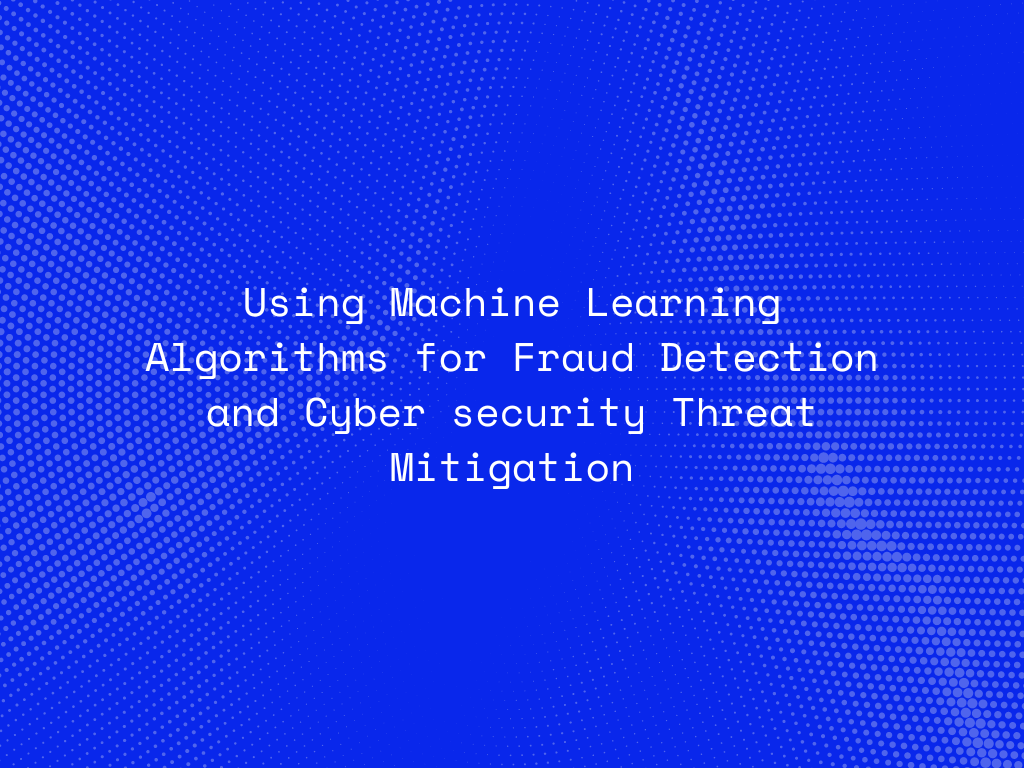In the digital age, businesses and individuals face a growing number of cybersecurity threats and fraudulent activities. To combat these challenges, organizations are increasingly turning to machine learning algorithms for fraud detection and cybersecurity threat mitigation. These advanced technologies can analyze vast amounts of data, identify patterns, and detect anomalies, providing robust defenses against malicious activities. In this blog post, we’ll explore how machine learning is transforming fraud detection and enhancing cybersecurity.
Understanding Machine Learning in Fraud Detection:
Machine learning (ML) is a subset of artificial intelligence (AI) that enables systems to learn from data and improve their performance over time without explicit programming. In the context of fraud detection, ML algorithms can analyze transaction data, user behavior, and other relevant metrics to identify suspicious activities and potential fraud. Key techniques used in ML for fraud detection include:
-
Supervised Learning: In supervised learning, ML models are trained on labeled datasets containing examples of both fraudulent and legitimate transactions. The model learns to distinguish between the two and can then predict the likelihood of fraud in new, unseen transactions.
-
Unsupervised Learning: Unsupervised learning involves training ML models on unlabeled data to identify patterns and anomalies that may indicate fraudulent activity. Techniques such as clustering and anomaly detection are commonly used to detect outliers in transaction data.
-
Reinforcement Learning: Reinforcement learning involves training models to make a series of decisions by rewarding desired outcomes and penalizing undesired ones. This approach can be used to optimize fraud detection systems and adapt to evolving threat landscapes.
-
Credit Card Fraud Detection: ML algorithms analyze transaction data in real-time to identify unusual spending patterns and flag potentially fraudulent transactions. By continuously learning from new data, these systems can detect emerging fraud tactics and reduce false positives.
-
Insurance Fraud Detection: ML models can analyze claims data to identify patterns indicative of fraudulent activities, such as exaggerated or fabricated claims. This helps insurance companies prevent financial losses and maintain the integrity of their services.
-
Identity Theft Prevention: ML algorithms can monitor user behavior across multiple channels to detect signs of identity theft. For example, if a user’s account suddenly exhibits unusual login locations or transaction patterns, the system can trigger alerts and initiate additional security measures.
Enhancing Cybersecurity with Machine Learning:
In addition to fraud detection, ML is playing a crucial role in enhancing cybersecurity by identifying and mitigating threats such as malware, phishing attacks, and network intrusions. Key applications of ML in cybersecurity include:
-
Intrusion Detection Systems (IDS): ML-powered IDS can analyze network traffic to detect abnormal patterns that may indicate a security breach. These systems can identify previously unknown attack vectors and adapt to new threats in real-time.
-
Malware Detection: ML algorithms can analyze the behavior and characteristics of files to detect malware. By learning from known malware samples, these systems can identify new and evolving malware strains, providing robust protection against cyber threats.
-
Phishing Detection: ML models can analyze emails and websites to detect phishing attempts. By examining factors such as URL structure, email content, and sender reputation, these systems can identify and block phishing attacks before they reach users.
Benefits of Using ML for Fraud Detection and Cybersecurity:
-
Improved Accuracy: ML algorithms can analyze large volumes of data and identify subtle patterns that may be missed by traditional rule-based systems, resulting in more accurate fraud detection and threat mitigation.
-
Real-Time Detection: ML-powered systems can process data in real-time, enabling organizations to detect and respond to fraudulent activities and cybersecurity threats as they occur.
-
Scalability: ML algorithms can scale to handle increasing volumes of data and adapt to evolving threat landscapes, ensuring continuous protection against new and emerging threats.
-
Reduced False Positives: By learning from historical data, ML models can reduce the number of false positives, minimizing unnecessary disruptions and improving the efficiency of security operations.
Conclusion:
Machine learning algorithms are revolutionizing the fields of fraud detection and cybersecurity by providing advanced, real-time analysis and detection capabilities. As cyber threats and fraudulent activities continue to evolve, leveraging ML technologies will be essential for organizations to protect their assets and maintain trust with their customers. By embracing ML for fraud detection and cybersecurity, businesses can stay one step ahead of malicious actors and ensure a safer digital environment.




